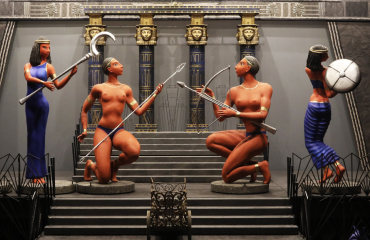Erarta Museum is proud to present the exhibition by Alexandra Ovchinnikova, who sees the souls of the cars
-
The secret life of abandoned cars
-
Comparative analysis of "Volga" and "Moskvich" personalities
-
The poetry of “car cemeteries”
Alexandra Ovchinnikova finds the cars of the 1950's and 1960's anthropomorphic. She peers into their “faces” during her long plein-airs in the Museum of Retro Cars. Such a place offers a number of fascinating challenges. The riot of wildflowers, pieces of paint peeling off the hundred times coated rusty vehicles, moss-covered car seats, and rounded body shapes are pretty to look at and cause the artist not only visual impressions but also elegiac emotions.
The art of romanticism has glorified the ancient ruins, tumble-down medieval castles and abandoned graves. The romanticists of the late twentieth century have already brought to notice the images of “autoruins”, hidden in the woods and city blind alleys: forgotten and beaten by the time, they grow into the ground and fall to pieces in the wind. And it is hard to imagine a person that is familiar with the romanticist poetics to be left indifferent. When coming across a skull of a ZIL truck with its silly grin, you unintentionally recall Hamlet’s monologue addressed to the dead court jester.
Probably, the designers did not accidentally create their cars so much similar to people’s nature. At the time when the streams of cars were flooding the city highways and country roads, the new technology had to be “humanized”. The traces of this adaptation remained in the urban folklore and a wide variety of texts. In a popular song of the 1960's by S. Kirsanov, Maya Kristalinskaya sang in a penetratingly voice: “It looks like there are two pupils in each of your eyes, like it is in the newest car models”.
Today, the car design has changed significantly, as well as the attitude to cars. But the language of auto enthusiasts still features psychological parallelism between a man and a machine. Along with the headlamps often called “eyes” or the wing mirrors called “ears”, the cars are still endowed with “faces”, “bodies”, “humps” and other characteristics of living nature. The cars’ nicknames are of a particular interest since they reveal the “personality” of the car, “written on its muzzle” or consonant with a foreign name.
For many people their car becomes a place of solitude and reflection, and even a friend to talk to. It is no coincidence that the car dumps are often called “cemeteries” or “graves”. The empty eye sockets of a “Volga” or “Moskvich” can really cause mournful feelings. In the picturesque series by Alexandra Ovchinnikova this tragic note is drowned out by the motley carnival of colors. The rusted skulls dressed in wreaths of cornflowers are dancing in a ring, showing off and claiming: “I ain’t no grandfather! I’m a veteran soldier! I carry fourteen wounds on my body!”







